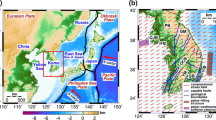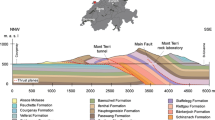Abstract
Changes in apparent electrical resistivity are calculated using one of the electrical survey methods—the median gradient—over the earthquake nucleation area in the shape of a sphere. Changes in the specific electrical resistivity of rocks in the source region of the earthquake nucleation are estimated taking into account the published estimates of changes in strain and strain-sensitivity coefficients. We consider the models where the sphere-shaped inclusion has a constant size in time and its electrical conductivity and depth of occurrence increase. Also considered is a model where the depth of the sphere is constant and the resistivity of the rocks in it decreases. A model is presented in which the size of the inhomogeneity increases with a simultaneous decrease in the electrical resistivity of rocks in it and the further localization of the decrease in a smaller volume, which corresponds to the ideas of tightening the nucleation zone of the main rupture into a narrow zone. According to this model, the graphs of changes in apparent resistivity return to background values shortly before the earthquake, i.e., changes in apparent resistivity over time will have the shape of a bay. A comparison of changes in electrical resistivity according to this model with variations in the resistivity of rocks at the Ashgabat Geodynamic Survey site, as well as limestone samples under laboratory conditions during their deformation and destruction, show their qualitative similarity and the possibility of using the results of laboratory tests of samples for modeling and analyzing the process of earthquake nucleation.





Similar content being viewed by others
REFERENCES
Avagimov, A.A., Dynamics of electromagnetic processes in the Kopetdag seismic active region, Extended Abstract of Doctoral (Phys.–Math.) Dissertation, Moscow: Garlavach, 1991.
Avagimov, A.A. and Lykov, V.I., On the nature of temporal fluctuations in electrical resistivity of rocks in active fault zones, Dokl. Akad. Nauk SSSR, 1982, vol. 263, no. 2, pp. 311–313.
Avagimov, A.A., Ataev, A.K., and Sukhomlin, V.G., Sounding by the field formation in the study of temporal changes in electrical conductivity of rocks in seismically active zones, Prognoz Zemletryasenii, 1984, no. 4, pp. 64–69.
Avaliani, Z.S. and Chelidze, T.L., Modeling electrical conductivity and the mechanical resistance effect in fracture media, Geofiz. Zh., 1981, vol. 15, no. 6, pp. 25–37.
Brace, W.F., Dilatancy-related electrical resistivity changes in rocks, Pure Appl. Geophys., 1975, vol. 113, pp. 207–217. https://doi.org/10.1007/BF01592911
Brace, W.F. and Orange, A.S., Further studies of effects of pressure on electrical resistivity of rocks, J. Geophys. Res., 1968a, vol. 73, no. 16, pp. 5407–5420. https://doi.org/10.1029/JB073i016p05407
Brace, W.F. and Orange, A.S., Electrical resistivity changes in saturated rocks during fracture and frictional sliding, J. Geophys. Res., 1968b, vol. 73, no. 4, pp. 1433–1445. https://doi.org/10.1029/JB073i004p01433
Brace, W.F., Orange, A.S., and Madden, T.R., The effect of pressure on the electrical resistivity of water-saturated crystalline rocks, J. Geophys. Res., 1965, vol. 70, no. 22, pp. 5669–5678. https://doi.org/10.1029/JZ070i022p05669
Chelidze, T.L., Metody teorii protekaniya v mekhanike geomaterialov (Flow Theory Methods in the Mechanics of Geological Materials), Moscow: Nauka, 1987.
Deshcherevskii, A.V. and Sidorin, A.Ya., Experimental studies of seasonal variations in apparent resistance in application to problems of seismology, Seism. Prib., 1999, vol. 32, pp. 62–75.
Dobrovol’skii, I.P., Matematicheskaya teoriya podgotovki i prognoza tektonicheskogo zemletryaseniya (Mathematical Theory of the Preparation and Prediction of Tectonic Earthquakes), Moscow: Fizmatlit, 2009.
Idarmachev, Sh.G., Variations of apparent electrical resistivity of rocks in seismic active regions of Dagestan, Doctoral (Phys.–Math.) Dissertation, Makhachkala, 2009.
Kissin, I.G., Strain sensitivity in fluid-saturated media, J. Volcanol. Seismol., 2011, vol. 5, no. 3, pp. 179–189.
Kuz’min, Yu.O., Mechanism of the formation of abnormal deformation processes during the preparation and implementation of the Ashkhabad earthquake, Vestn. Otd. Nauk Zemle Ross. Akad. Nauk, 1998, no. 2, pp. 135–151.
Kuz’min, Yu.O. and Churikov, V.A., Mechanism of the formation of abnormal deformation processes during the preparation of the Kamchatka earthquake of March 2, 1992, Vulkanol. Seismol., 1998, no. 6, pp. 37–51.
Kuz’min, Yu.O. and Zhukov, V.S., Sovremennaya geodinamika i variatsii fizicheskikh svoistv gornykh porod (Modern Geodynamics and Variations in Physical Properties of Rocks), Moscow: MGGU, 2004.
Moiseenko, U.I., Istomin, V.B., and Ushakov, G.D., Influence of uniaxial pressure on electrical resistivity of rocks, Dokl. Akad. Nauk SSSR, 1964, vol. 154, no. 2, pp. 366–368.
Morrow, C. and Brace, W.F., Electrical resistivity changes in tuff due to stress, J. Geophys. Res., 1981, vol. 86, no. B4, pp. 2929–2934. https://doi.org/10.1029/JB086iB04p02929
Parkhomenko, E.I. and Bondarenko, A.T., Influence of uniaxial pressure on electrical resistivity of rocks, Izv. Akad. Nauk SSSR, Ser. Geofiz., 1960, no. 2, pp. 326–392.
Ponomarev, A.V., Dynamics of physical fields in modeling the source of earthquake, Doctoral (Phys.–Math.) Dissertation, Moscow, 2003.
Pushkarev, V.N. and Sidorin, A.Ya., Comparison of the sensitivity of different methods of electrical prospecting in application to the problem of search for earthquake precursors, Seism. Prib., 2002, vol. 37, pp. 74–85.
Riznichenko, Yu.V., The size of the source of a crustal earthquake and the seismic moment, in Issledovaniya po fizike zemletryasenii (Studies on the Physics of Earthquakes), Moscow: Nauka, 1965, pp. 9–26.
Sidorin, A.Ya., Garmskii geofizicheskii poligon (The Garm Geophysical Polygon), Moscow: IFZ AN SSSR, 1990.
Sidorin, A.Ya., Predvestniki zemletryasenii (Earthquake Precursors), Moscow: Nauka, 1992.
Sidorin, A.Ya., Electrical resistivity of rocks as a sensitive sensor of changes in their strain and deformation, Nauka Tekhnol. Razrab., 2020, vol. 99, no. 2, pp. 38–48. https://doi.org/10.21455/std2020.2-3
Sidorin, A.Ya. and Fitterman, D.V., Using methods of direct current and sounding by the field formation in search for earthquake precursors, in Zemletryaseniya i protsessy ikh podgotovki (Earthquakes and the Processes of Their Preparation), Moscow: Nauka, 1991, pp. 64–67.
Sidorin, A.Ya. and Zhuravlev, V.I., Estimation of the size of earthquake preparation zones according to electrical sounding data, in Modelirovanie predvestnikov zemletryasenii (Modeling of Earthquake Precursors), Moscow: Nauka, 1980, pp. 45–54.
Sobolev, G.A. and Kol’tsov, A.V., Krupnomasshtabnoe modelirovanie podgotovki i predvestnikov zemletryasenii (Large-Scale Modeling of the Earthquake Preparation and Precursors), Moscow: Nauka, 1988.
Sobolev, G.A. and Ponomarev, A.V., Fizika zemletryasenii i predvestniki (Physics of Earthquakes and Precursors), Moscow: Nauka, 2003.
Sun, Q., Zhu, S., and Xu, L., Electrical resistivity variation in uniaxial rock compression, Arab. J. Geosci., 2015, vol. 8, pp. 1869–1880. https://doi.org/10.1007/s12517-014-1381-3
Zhdanov, M.S., Elektrorazvedka. Uchebnik dlya vuzov (Electrical Prospecting. A Study Guide for Universities), Moscow: Nedra, 1986.
Zhukov, V.S., Study of variations in the electrotelluric field and electrical resistivity of rocks in the Ashkhabad seismic active region, Cand. Sci. (Phys.–Math.) Dissertation, Ashkhabad, 1984.
Zhuravlev, V.I., A linearized inverse problem of electrical prospecting, Dokl. Akad. Nauk SSSR, 1979, vol. 248, no. 1, pp. 64–66.
Funding
This work was supported by the State Task of the Institute of Physics of the Earth, Russian Academy of Sciences, “Geophysical Fields of Middle Latitudes: Monitoring and Modeling” (state registration number АААА-А17-117040610184-3).
Author information
Authors and Affiliations
Corresponding author
Ethics declarations
The authors declare they have no conflicts of interest.
Rights and permissions
About this article
Cite this article
Zhukov, V.S., Mostryukov, A.O. Possibilities of Using the Method of Median Gradients to Reveal Changes in Apparent Electrical Resistivity during the Nucleation of Earthquakes. Izv. Atmos. Ocean. Phys. 58, 925–935 (2022). https://doi.org/10.1134/S0001433822080084
Received:
Revised:
Accepted:
Published:
Issue Date:
DOI: https://doi.org/10.1134/S0001433822080084




